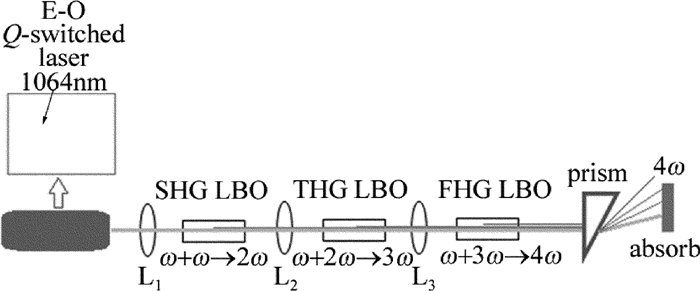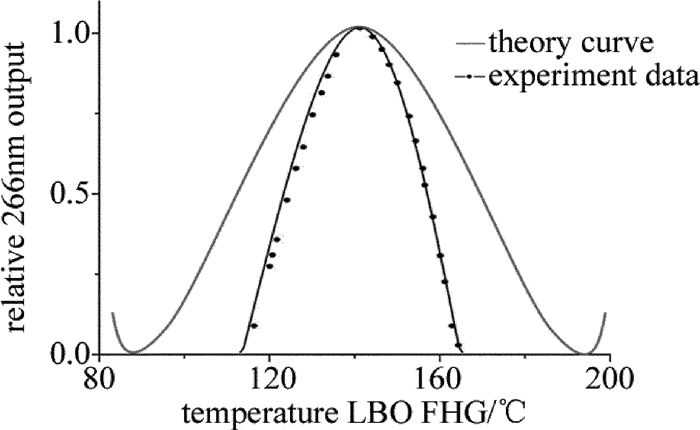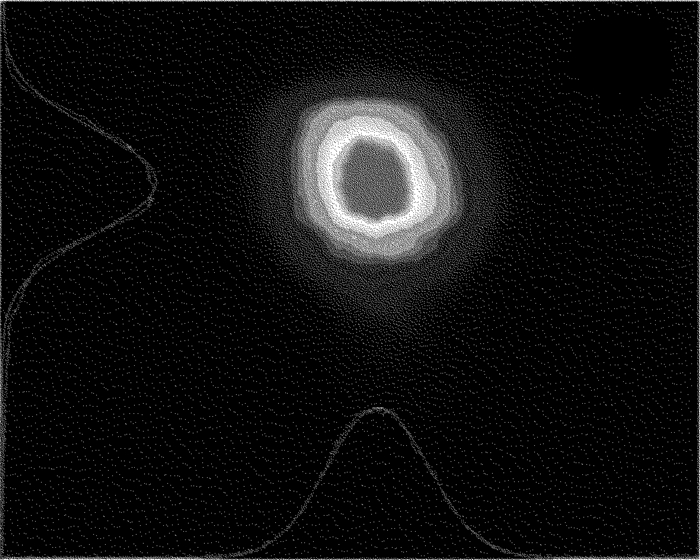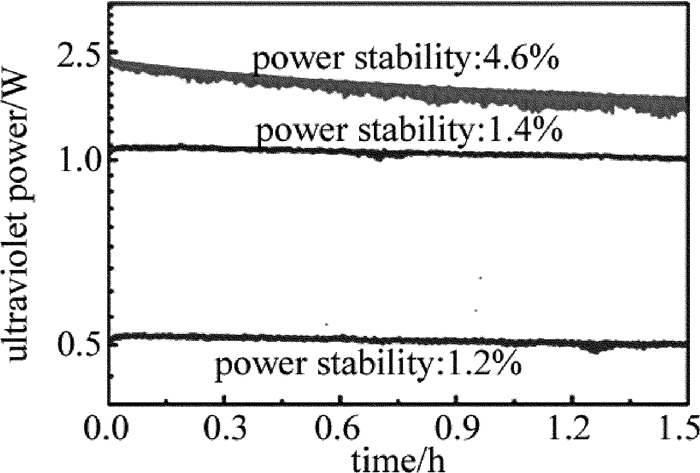High power ultraviolet pulsed lasers based on LBO crystal
-
摘要: 为了获得高功率、高重复频率的紫外脉冲激光器,采用1064nm基频光通过三硼酸锂(LBO)晶体与3次谐波355nm进行和频得到4次谐波266nm紫外激光的方法,进行了实验验证,取得了重复频率为20kHz、紫外激光器的平均输出功率为2.5W、红外到紫外的转换效率为12.5%的实验数据。结果表明,此脉冲激光器利用LBO晶体在高重复频率下取得了较大的紫外平均输出功率。Abstract: In order to achieve the ultraviolet pulsed laser with the high power and high frequency, the fourth harmonic 266nm in LiB3O5 (LBO)crystal was generated by frequency mixing of the fundamental(1064nm) and third harmonic (355nm) of electro-optical Q-switched laser, and experiment verification was carried out. Deep ultraviolet (UV) output power of 2.5W at 266nm with the repetition rate at 20kHz and 12.5% infrared(IR)-to-UV conversion efficiency were achieved. The result show that the pulse laser has achieved a large average output power at high repetition frequency by using LBO crystal.
-
引言
紫外激光器在医疗、科学研究、工业生产[1-5]等方面都有广泛的应用。相比于红外和可见光波段的激光器,紫外激光具有较高的单光子能量和更小的光焦。为了得到高重复频率、高单脉冲能量以及窄线宽的266nm紫外激光,采用1064nm的脉冲激光器利用三硼酸锂(LiB3O5,LBO)或偏硼酸钡(β-BaB2O4,BBO)晶体倍频2次谐波(the second harmonic generation,SHG)得到532nm绿光,再通过工作在紫外波段的如RbBe2BO3F2(RBBF)[6],K2Al2B2O7(KABO)[7],KBe2BO3F2 (KBBF)[8],BBO[9]角度相位匹配技术或者KD2PO4 (KD*P)[10]非临界相位匹配技术进行倍频,即4次谐波效应(the fourth harmonic generation,FHG)获得266nm的紫外激光输出。常见的晶体主要有BBO和磷酸二氘钾(KD2PO4,KD*P),但上述晶体在紫外波段都易于潮解,而且KD*P具有较低的热传导率,只能在重复频率100Hz以下工作,BBO有较大的走离角、角度相位匹配范围较窄、较高的吸收率通常在重复频率10kHz以下可以得到较好的紫外光输出。
LBO晶体的通光范围在200nm以下,其光学均匀性好、损伤阈值高、非线性光学系数适中、走离角小、允许角大等优点,可以利用3次谐波技术(the third harmonic generation,THG)获得355nm[11]的紫外光,由于双折射效应,利用LBO晶体在Ⅰ类角度匹配条件下不能通过SHG得到的532nm四倍频输出266nm的紫外激光,通过四倍频技术最短波长只能达到277nm[12]。
本文中报道了利用基于电光调Q脉冲激光器1064nm基频光通过LBO晶体与产生的3次谐波355nm进行和频得到266nm的紫外激光输出。全固态紫外脉冲激光器在重复频率为20kHz条件下获得平均输出功率为2.5W的266nm紫外光,其在1.5h内测得输出功率稳定度为4.6%。
1. 实验装置
获得266nm的紫外激光输出需要具有高单脉冲能量,窄脉冲宽度1064nm基频光。实验的光路如图 1所示。基于Bright Solutions公司商用Onda电光(electro-optic,E-O)调Q脉冲激光器,可以获得脉冲宽度为8ns的1064nm激光输出,光束质量因子M2 < 1.5, 在重复频率为20kHz时最大的平均输出功率可达20W。
图 1中ω表示基频的光波,2ω表示2次谐波,以此类推。基频光1064nm经过透镜L1在第1个LBO晶体进行倍频(SHG)得到532nm的输出光,再通过透镜L2后基频光1064nm和倍频光532nm经过THG LBO晶体和频得到3次谐波355nm,最后通过透镜L3基频光1064nm与3次谐波355nm在FHG LBO晶体相互作用得到4次谐波266nm的紫外激光输出。SHG LBO晶体采用的相位匹配(phase-matching,PM)方式是Ⅰ类非临界相位匹配(non critical phase matc-hing,NCPM), 匹配温度是148℃,其走离角近似为0mrad,晶体尺寸为3mm × 3mm × 20mm;THG LBO是Ⅱ类角度相位匹配,匹配角θ=47°, φ=90°;FHG LBO是Ⅰ类角度相位匹配,匹配角θ=90°, φ=61°。3个晶体具体参量见表 1,其中οz, ω表示入射光为慢光偏振态,偏振方向沿着z轴;exy, 2ω表示产生的2次谐波是快光偏振态,偏振方向在x-y平面;下标ω表示基频的光波,2ω表示2次谐波,以此类推。
Table 1. Characteristics of LBO crystalcrystal PM type PM scheme walk-off angle[13] PM angle PM temperature dimensions SHG LBO Ⅰ οz, ω+οz, ω→exy, 2ω 0mrad θ=90°, φ=0° 148℃ 3mm×3mm×20mm THG LBO Ⅱ οz, ω+exy, 2ω→οz, 3ω 10mrad θ=47°, φ=90° 60℃ 3mm×3mm×15mm FHG LBO Ⅰ οz, ω+οz, 3ω→exy, 4ω 16mrad θ=90°, φ=61° 140℃ 3mm×3mm×20mm 光束通过分光棱镜后,基频光1064nm、倍频光532nm、3次谐波355nm被光学吸收器转化为热能, 从而266nm紫外激光输出,通过光电探测器和功率计测出266nm的脉冲宽度和平均输出功率。L1, L2, L3聚焦透镜的作用是把输出光汇聚在LBO晶体的中心点,LBO晶体和聚焦透镜镀减反膜(anti-reflection,AR)的参量见表 2。SHG LBO晶体入射面和出射面镀对1064nm/532nm波长的减反膜,聚焦透镜L1入射面和出射面镀对1064nm波长的减反膜,L2入射面和出射面镀对1064nm/532nm波长的减反膜,L3入射面和出射面镀对355nm波长的减反膜,THG LBO和FHG LBO两个晶体无需镀膜。
Table 2. Antireflection coating of optical componentsLBO crystals lenses SHG LBO THG LBO FHG LBO L1(f=35mm) L2(f=57mm) L3(f=57mm) input output input output input output input output input output input output AR 1064nm/532nm uncoated uncoated AR 1064nm AR 1064nm/532nm AR 355nm 2. 实验结果与讨论
基频光1064nm通过第1个LBO晶体进行倍频(SHG)得到532nm的输出光,最大的平均输出功率为14.5W,转换效率为72.5%,通过调节SHG LBO晶体的温度可以得到基频光1064nm与倍频(SHG)532nm不同的输出比率,当SHG LBO晶体温度为148℃,通过SHG平台后输出的基频光1064nm光功率与倍频(SHG)532nm光功率的比值为1.2,即1064nm光功率10.8W,532nm光功率9W,可以得到3次谐波(THG)355nm最大输出功率为6W,转换效率为30%, 如图 2所示。
基频光1064nm和3次谐波(THG)355nm通过FHG LBO获得266nm的激光输出。分离出来的4次谐波266nm紫外激光在重复频率20kHz时最大输出功率为2.5W,转换效率为12.5%,如图 3所示。
FHG LBO晶体Ⅰ类角度相位匹配角晶体温度的关系通过基于KATO的LBO Sellmeier方程SNLO软件计算得到温度匹配带宽为55℃,范围很大,但是实际测量的温度匹配带宽比较窄,如图 4所示。这可能是由于在晶体温度65℃~250℃变化范围,Sellmeier方程中没有考虑LBO晶体对于波长200nm~400nm入射光的吸收损耗引起的。
在重复频率20kHz时测得输出266nm紫外光的脉冲宽度为10ns, 如图 5所示,较基频光有一定的展宽。
由于FHG LBO的走离角比较小,在距离FHG LBO大约1m处测得266nm紫外光输出的能量分布,如图 6所示。同时在1.5h内测得输出功率为0.5W以及1W的稳定度分别好于1.2%和1.4%,在最大输出功率为2.5W时,其稳定度可以达到4.6%,如图 7所示。
高功率抽运激光工作较长时间情况下,THG LBO晶体出现了降解现象[14-15],通过带有CMOS的数码显微镜观测到了具体的降解区域,如图 8所示。实验过程中发现, 出现降解现象的特征时间从几个小时到几百个小时不等,降解程度与激光以及晶体的诸多参量有关,还需要进一步地研究其原因,进行改善。
3. 结论
采用电光调Q获得了脉宽为8ns的高质量1064nm基频光,通过LBO晶体与产生的3次谐波355nm进行和频得到266nm的紫外激光输出。在重复频率为20kHz时,紫外光最大平均输出功率为2.5W,脉冲宽度10ns,相应的红外到紫外的转换效率为12.5%,其稳定度可以达到4.6%。同时,后续可以通过增大基频光的峰值功率提高转换效率。此外,长时间工作导致LBO晶体出现了降解现象,还需进一步研究。
-
Table 1 Characteristics of LBO crystal
crystal PM type PM scheme walk-off angle[13] PM angle PM temperature dimensions SHG LBO Ⅰ οz, ω+οz, ω→exy, 2ω 0mrad θ=90°, φ=0° 148℃ 3mm×3mm×20mm THG LBO Ⅱ οz, ω+exy, 2ω→οz, 3ω 10mrad θ=47°, φ=90° 60℃ 3mm×3mm×15mm FHG LBO Ⅰ οz, ω+οz, 3ω→exy, 4ω 16mrad θ=90°, φ=61° 140℃ 3mm×3mm×20mm Table 2 Antireflection coating of optical components
LBO crystals lenses SHG LBO THG LBO FHG LBO L1(f=35mm) L2(f=57mm) L3(f=57mm) input output input output input output input output input output input output AR 1064nm/532nm uncoated uncoated AR 1064nm AR 1064nm/532nm AR 355nm -
[1] LI Q, THOMAS RUCKSTUHL A, SEEGER S. Deep-UV laser-based fluorescence lifetime imaging microscopy of single molecules[J]. Journal of Physical Chemistry, 2004, B108(24):8324-8329. http://www.wanfangdata.com.cn/details/detail.do?_type=perio&id=78a2223db963400523d577af87b1198a
[2] LE H R, KÖNIG K, WVLLNER C, et al. Ultraviolet femtosecond laser creation of corneal flap[J]. Journal of Refractive Surgery, 2009, 25(4):383-389. DOI: 10.3928/1081597X-20090401-08
[3] PARK S J, SONG J H, LEE G A. Analysis of UV laser machining process for high density embedded IC substrates[J].Advanced Materials Research, 2012, 630(5):171-174. http://www.wanfangdata.com.cn/details/detail.do?_type=perio&id=10.4028/www.scientific.net/AMR.630.171
[4] ORTHAUS S, KÖNIG M, SCHÖNAU T, et al. Crossing the limit towards deep UV[J]. Optik & Photonik, 2013, 8(1):33-36. DOI: 10.1002/opph.201300001/abstract
[5] KONG L R, ZHANG F, DUAN J, et al. Research of water-assisted laser etching of alumina ceramics[J]. Laser Technology, 2014, 38(3):330-334(in Chinese). http://www.wanfangdata.com.cn/details/detail.do?_type=perio&id=jgjs201403010
[6] CHEN C, LUO S, WANG X, et al. Deep UV nonlinear optical crystal:RbBe2BO3F2[J]. Journal of the Optical Society of America, 2009, B26(8):1519-1525. http://d.old.wanfangdata.com.cn/Periodical/rgjtxb98200101004
[7] WANG Y, WANG L, GAO X, et al. Growth, characterization and the fourth harmonic generation at 266nm of K2Al2B2O7 crystals without UV absorptions and Na impurity[J]. Journal of Crystal Growth, 2012, 348(1):1-4. http://www.wanfangdata.com.cn/details/detail.do?_type=perio&id=96eacce554c5e8282e27f918db784f94
[8] WANG L, ZHAI N, LIU L, et al. High-average-power 266nm generation with a KBe2BO3F2 prism-coupled device[J]. Optics Express, 2014, 22(22):27086-27090. DOI: 10.1364/OE.22.027086
[9] CHAITANYA K S, CANALS C J, SANCHEZ B E, et al. Yb-fiber-laser-based, 1.8W average power, picosecond ultraviolet source at 266nm[J]. Optics Letters, 2015, 40(10):2397-2400. DOI: 10.1364/OL.40.002397
[10] YANG S T, HENESIAN M A, WEILAND T L, et al. Noncritically phase-matched fourth harmonic generation of Nd:glass lasers in partially deuterated KDP crystals[J]. Optics Letters, 2011, 36(10):1824-1828. DOI: 10.1364/OL.36.001824
[11] ZHENG B R, YAO Y Ch, HUANG Ch Y. Experiment of double-end-pumped intra-cavity triple frequency ultraviolet laser[J].Laser Technology, 2013, 37(2):155-157(in Chinese). http://www.wanfangdata.com.cn/details/detail.do?_type=perio&id=jgjs201302005
[12] CHEN C. Chinese lab grows new nonlinear optical borate crystals[J]. Laser Focus World, 1989, 25(11):129-137.
[13] SMITH A V. Software for calculated "SNLO version_52."[CP/OL]. (2000-02-15)[2009-06-12]. http://www.sandia.gov/pcnsc/departments/lasers/snlo-software.html.
[14] MÖLLER S, ANDRESEN A, MERSCHJANN C, et al. Insight to UV-induced formation of laser damage on LiB3O5 optical surfaces during long-term sum-frequency generation[J]. Optics Express, 2007, 15(12):7351-7356. DOI: 10.1364/OE.15.007351
[15] HONG H, LIU Q, HUANG L, et al. Improvement and formation of UV-induced damage on LBO crystal surface during long-term high-power third-harmonic generation[J]. Optics Express, 2013, 21(6):7285-7293. DOI: 10.1364/OE.21.007285




 下载:
下载:






